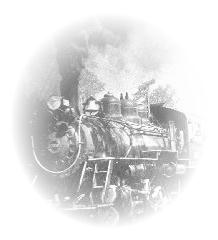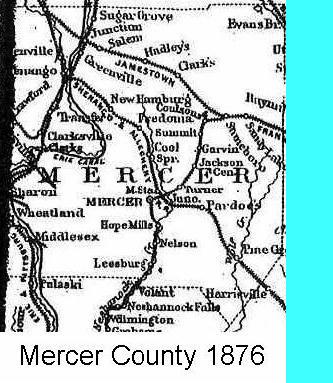

Dreams of more efficient methods of transportation to increase commerce and open the expanding western frontier go all the way back to American colonial times. Many of these dreams were beginning to be fulfilled in the early years of the nineteenth century with the construction of canals. The most famous of these, of course, being the Erie Canal linking the Great Lakes with the Hudson River and New York City. For a fairly brief period canals became the dominant mode of transportation, and they were being built all over the landscape of the newly-formed nation. Western Pennsylvania was indeed no exception. The Erie Extension Canal (also known as the Great Lakes and Pittsburgh Canal) was established to link Lake Erie with the Ohio River, which was then the main water route for western expansion.
By the middle of the nineteenth century, the railroads were beginning to supplant the canals, as the steam engine was rapidly beginning to replace the brute strength of the mules that towed the canal boats. While canals needed a steady supply of water to float their boats, they usually followed rivers and streams. Railroads, on the other hand, could be built just about anywhere physically possible. Hence, the railroads soon became the dominant mode of transportation as the nation moved into the latter half of the nineteenth century. In fact, the Erie & Pittsburgh Railroad bought the Erie Extension Canal toward the end of its existence and eventually built on its right of way .
Throughout the nineteenth century the dominant industry in Western Pennsylvania was coal mining. Being the prominant fuel of the day, coal was in high demand. Railroads provided a very efficient means to connect the product of the mines to the demands of the consumer. While the railroads of the early days delivered a wide variety of goods, their major venue was coal. In fact, the railroads themselves ran on coal -- the steam-driven engines in the locomotives were powered by burning coal. So it comes as no surprise that many railroads were established to serve the coal mines and their customers.
Most of the original settlements in Western Pennsylvania were founded on rivers, the water providing the mechanical power to run grist mills and the like, With the coming of the steam age, whole new towns sprang up in the vicinity of the coal mines, engines of the new economy. In Mercer County, in particular, many of the primary villages grew up around the Shenango River in the west, Cool Spring, Otter, and Neshannock Creeks near the center, and Wolf Creek in the east. The Shenango gave birth to West Middlesex, Wheatland, Sharon, Sharpsville, and Greenville. The county seat of Mercer was founded upon the confluence of Otter and Coolspring, where they form the Neshannock, while the town of Pine Grove (now Grove City) was started on Wolf Creek.
 There were many coal mining operations in the western part of the county near the Shenango Valley in Hickory Township (now the city of Hermitage). Mines with names like Oakland, Ormsby, and Mount Pleasant dotted the landscape. The coal mining towns of New Virginia, Bethel, and Neshannock became boom towns practically overnight as the demand for coal increased. Likewise, in the eastern part of the county, towns such as Pardoe and Irishtown also blossomed in the coal boom. And the railroad trackage grew by leaps and bounds as well. Railroads with names that have all but been forgotten, such as Sharpsville & Oakland (later simply Sharpsville), Sharon & Greenfield, New Castle & Franklin, and Shenango & Allegheny. There were also the Erie & Pittsburgh Railroad (which was eventually to become part of the Pennsylvania, later the Penn-Central) and the Atlantic & Great Western Railroad (later the Erie and Erie Lackawanna), both of which became part of Conrail. To the left is a map of Mercer County from 1876 that shows the major railroads of the day. Some of them still exist, albeit with different names. And some of them no longer exist, but still reveal their impact upon the landscape in some places. Long gone, but not completely forgotten, these pioneering railways of Mercer County live on in many ways.
There were many coal mining operations in the western part of the county near the Shenango Valley in Hickory Township (now the city of Hermitage). Mines with names like Oakland, Ormsby, and Mount Pleasant dotted the landscape. The coal mining towns of New Virginia, Bethel, and Neshannock became boom towns practically overnight as the demand for coal increased. Likewise, in the eastern part of the county, towns such as Pardoe and Irishtown also blossomed in the coal boom. And the railroad trackage grew by leaps and bounds as well. Railroads with names that have all but been forgotten, such as Sharpsville & Oakland (later simply Sharpsville), Sharon & Greenfield, New Castle & Franklin, and Shenango & Allegheny. There were also the Erie & Pittsburgh Railroad (which was eventually to become part of the Pennsylvania, later the Penn-Central) and the Atlantic & Great Western Railroad (later the Erie and Erie Lackawanna), both of which became part of Conrail. To the left is a map of Mercer County from 1876 that shows the major railroads of the day. Some of them still exist, albeit with different names. And some of them no longer exist, but still reveal their impact upon the landscape in some places. Long gone, but not completely forgotten, these pioneering railways of Mercer County live on in many ways.
New Castle & Franklin Railroad